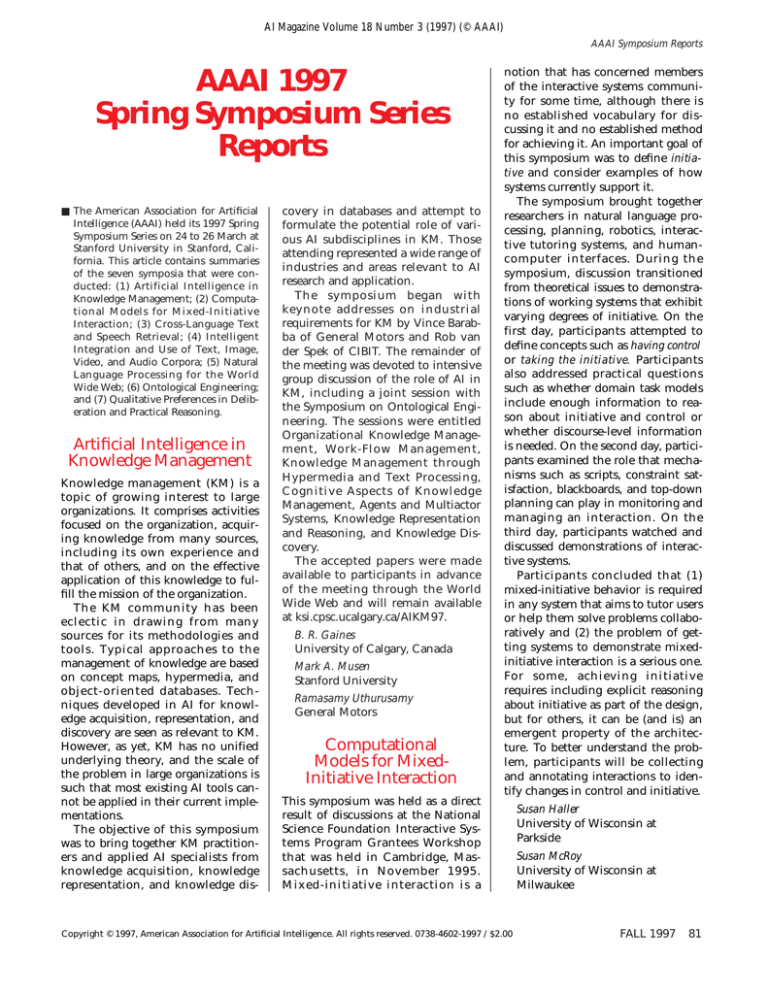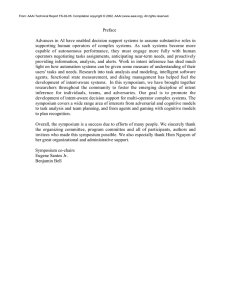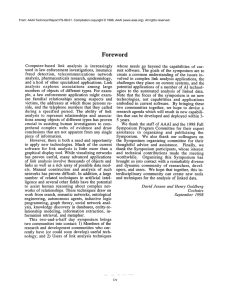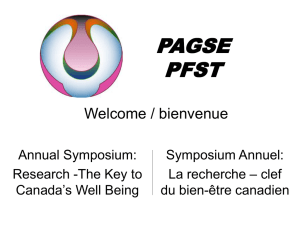
AI Magazine Volume 18 Number 3 (1997) (© AAAI)
AAAI Symposium Reports
AAAI 1997
Spring Symposium Series
Reports
■ The American Association for Artificial
Intelligence (AAAI) held its 1997 Spring
Symposium Series on 24 to 26 March at
Stanford University in Stanford, California. This article contains summaries
of the seven symposia that were conducted: (1) Artificial Intelligence in
Knowledge Management; (2) Computational Models for Mixed-Initiative
Interaction; (3) Cross-Language Text
and Speech Retrieval; (4) Intelligent
Integration and Use of Text, Image,
Video, and Audio Corpora; (5) Natural
Language Processing for the World
Wide Web; (6) Ontological Engineering;
and (7) Qualitative Preferences in Deliberation and Practical Reasoning.
Artificial Intelligence in
Knowledge Management
Knowledge management (KM) is a
topic of growing interest to large
organizations. It comprises activities
focused on the organization, acquiring knowledge from many sources,
including its own experience and
that of others, and on the effective
application of this knowledge to fulfill the mission of the organization.
The KM community has been
eclectic in drawing from many
sources for its methodologies and
tools. Typical approaches to the
management of knowledge are based
on concept maps, hypermedia, and
object-oriented databases. Techniques developed in AI for knowledge acquisition, representation, and
discovery are seen as relevant to KM.
However, as yet, KM has no unified
underlying theory, and the scale of
the problem in large organizations is
such that most existing AI tools cannot be applied in their current implementations.
The objective of this symposium
was to bring together KM practitioners and applied AI specialists from
knowledge acquisition, knowledge
representation, and knowledge dis-
covery in databases and attempt to
formulate the potential role of various AI subdisciplines in KM. Those
attending represented a wide range of
industries and areas relevant to AI
research and application.
The symposium began with
keynote addresses on industrial
requirements for KM by Vince Barabba of General Motors and Rob van
der Spek of CIBIT. The remainder of
the meeting was devoted to intensive
group discussion of the role of AI in
KM, including a joint session with
the Symposium on Ontological Engineering. The sessions were entitled
Organizational Knowledge Management, Work-Flow Management,
Knowledge Management through
Hypermedia and Text Processing,
Cognitive Aspects of Knowledge
Management, Agents and Multiactor
Systems, Knowledge Representation
and Reasoning, and Knowledge Discovery.
The accepted papers were made
available to participants in advance
of the meeting through the World
Wide Web and will remain available
at ksi.cpsc.ucalgary.ca/AIKM97.
B. R. Gaines
University of Calgary, Canada
Mark A. Musen
Stanford University
Ramasamy Uthurusamy
General Motors
Computational
Models for MixedInitiative Interaction
This symposium was held as a direct
result of discussions at the National
Science Foundation Interactive Systems Program Grantees Workshop
that was held in Cambridge, Massachusetts, in November 1995.
Mixed-initiative interaction is a
notion that has concerned members
of the interactive systems community for some time, although there is
no established vocabulary for discussing it and no established method
for achieving it. An important goal of
this symposium was to define initiative and consider examples of how
systems currently support it.
The symposium brought together
researchers in natural language processing, planning, robotics, interactive tutoring systems, and humancomputer interfaces. During the
symposium, discussion transitioned
from theoretical issues to demonstrations of working systems that exhibit
varying degrees of initiative. On the
first day, participants attempted to
define concepts such as having control
or taking the initiative. Participants
also addressed practical questions
such as whether domain task models
include enough information to reason about initiative and control or
whether discourse-level information
is needed. On the second day, participants examined the role that mechanisms such as scripts, constraint satisfaction, blackboards, and top-down
planning can play in monitoring and
managing an interaction. On the
third day, participants watched and
discussed demonstrations of interactive systems.
Participants concluded that (1)
mixed-initiative behavior is required
in any system that aims to tutor users
or help them solve problems collaboratively and (2) the problem of getting systems to demonstrate mixedinitiative interaction is a serious one.
For some, achieving initiative
requires including explicit reasoning
about initiative as part of the design,
but for others, it can be (and is) an
emergent property of the architecture. To better understand the problem, participants will be collecting
and annotating interactions to identify changes in control and initiative.
Copyright © 1997, American Association for Artificial Intelligence. All rights reserved. 0738-4602-1997 / $2.00
Susan Haller
University of Wisconsin at
Parkside
Susan McRoy
University of Wisconsin at
Milwaukee
FALL 1997
81
AAAI Symposium Reports
Cross-Language Text and
Speech Retrieval
Cross-language text retrieval (CLTR) is
the problem of matching a query in
one language to related documents in
other languages. As internet resources
such as the World Wide Web have
become global networks, many new
and important markets for this technology have been created, particularly in multinational corporations and
multilingual nations. For those people whose job it is to follow world
events as they happen and track the
local response, there are strong incentives to use information filters that
do not require full translation to
access breaking news reports.
CLTR adds new twists to many traditional problems in information
retrieval (IR) and computational linguistics. A CLTR system matches
queries and documents in different
languages by using bilingual dictionaries and thesauri for query translation or applying corpus-based techniques such as latent semantic
indexing or cross-language query
expansion. Dictionary-based systems
must deal with translation ambiguity,
and we have seen work based on
word-sense disambiguation, part-ofspeech tagging, syntactic analysis,
query expansion, and Boolean models to address this problem. All the
important user interface issues in IR,
such as the organization of search
results and document presentation,
are magnified in the multilingual
domain, where one generally cannot
assume that the user is fluent in the
document language(s). Our symposium also brought in researchers from
the speech-retrieval community
because speech retrieval (from textbased queries) and CLTR share the
common property that the query and
the information source do not have
directly comparable representations.
We even heard about some recent
experiments in cross-language speech
retrieval, a task that truly stretches
the limits of modern recognition and
retrieval technology.
Douglas Oard
University of Maryland
David Hull
Rank Xerox Research Centre
82
AI MAGAZINE
Intelligent Integration and
Use of Text, Image, Video,
and Audio Corpora
Natural Language
Processing for the
World Wide Web
The presentations made at this symposium dealt with vastly different environments, ranging from digital libraries
and broadcast news archives to virtual
reality and, of course, the web.
There were two types of text, image,
video, and audio (TIVA) integration:
(1) data from one modality are used to
improve and enable processing in
another modality (leverage) and (2)
multiple modalities were integrated to
improve and enable overall system
functions (concurrent integration).
Individual participants discussed
the integration of images and text for
finding captions, image retrieval,
music retrieval, news broadcast segmentation, gaze tracking and speech,
the analysis of video and audio,
information retrieval and speech
recognition, user studies, and formal
logic to integrate image and semantic
text representations.
Approaches to integrating TIVA
sources included the following: First,
features in separate modalities can be
combined into a uniform vector representation suitable for learning. Second, in partially synchronized data,
Viterbi alignment enables identification of correspondences across
modalities. Third, heuristics can
allow approximate matching across
modalities. Fourth, hand-coded rules
allow association of multiple feature
types. Fifth, decision trees can learn
the influence of one modality’s data
on another. Frequently, particular
approaches could be applied in totally disparate modalities.
The presented research results
could not be compared meaningfully
because they were obtained on relatively small, private corpora. All participants agreed that the research
would benefit tremendously from
corpora that included multiple
modalities, for example, a standard,
large, public-domain database of text
with pictures or a database of labeled
broadcast video, including speech,
music, and other sounds.
This symposium brought together
researchers in natural language processing (NLP) from both academia
and industr y, including ser vice
providers on the World Wide Web.
The purpose of the symposium was
to discuss whether and how NLP
techniques based on the syntax and
semantics of natural languages could
improve services on the web. A wide
variety of technical approaches and
application systems were demonstrated during the symposium, many of
which were shown live off the web.
The response to the symposium in
terms of both papers submitted and
the number of registrations and the
enthusiasm of the participants were
overwhelming.
It was encouraging to see practical
applications of NLP for improved precision in document retrieval, natural
language interfaces for better document search, semantic indexing of
web pages, summarization and information extraction, machine translation of foreign-language web pages,
question answering on the web,
speech interfaces to web services, and
dynamic creation of web pages using
natural language–generation techniques. In addition, a position paper
on the nature of the web for linguistic processing was presented.
Most of the discussions during the
symposium focused on identifying
key problems in web services where
the application of NLP would make a
difference. Many real-life problems in
providing web services were presented by the participants from web service organizations. A consensus was
reached that even if prior experiments had failed to show the benefit
of NLP for information retrieval, the
web offers many other critical problems for which NLP techniques are
highly promising. Among such problems are query elicitation from users,
question answering, summarization,
topic spotting, machine translation,
and document generation.
Alexander Hauptmann
Michael Witbrock
Carnegie Mellon University
Kavi Mahesh
New Mexico State University
AAAI Symposium Reports
The purpose of the symposium was to
discuss whether and how NLP techniques
based on the syntax and semantics of
natural languages could improve services
on the World Wide Web.
Ontological Engineering
Explicit ontologies that suppor t
knowledge reuse, system integration,
interoperability, and related tasks are
becoming increasingly important. As
ontology use becomes widespread, we
must come to a greater understanding of the engineering issues relating
to these ontologies. This symposium
was convened to discuss current practices in engineering ontologies rather
than the foundational issues raised at
previous workshops.
A secondary goal of the symposium was to foster a stronger sense
of community by sharing and drawing from our concrete experiences in
developing and using ontologies. In
the past, achieving this goal has
been hampered by the interdisciplinary nature of the field, with
research arising from knowledge
base sharing and reuse, natural language processing, database schemas,
and various standards efforts. For
this reason, the workshop was organized around group discussions
based on major topics and challenges in ontological engineering.
This format encouraged participants
to exchange the sort of critical information based in the experiences that
often do not find their way into
more formal papers and presentations.
Groups met to discuss the uses of
ontologies; the reuse of ontologies;
the form and content of ontologies;
methodologies for designing, building, and evaluating ontologies;
techniques for structuring libraries
of ontologies; techniques for merging and integrating ontologies; and
tools for supporting ontological
engineering.
Major issues to arise fr om the
workshop were the increasing importance of merging ontologies and the
problem of translating between
ontologies. Many ontologies have
been designed, ranging from ontologies for specialized domains such as
medicine, law, products, and processes to the upper-level ontologies used
in natural language processing. The
challenge for the community will be
the integration of all these efforts in
such a way that we can realize the
original vision of reuse and sharing.
There were stark contrasts among
the purposes that participants used
ontologies for and the pressures that
these purposes placed on ontology
design. For example, some participants required full axiomatizations to
support automated inference, whereas others required broad coverage to
support natural language processing.
In spite of the differences in purpose among participants, there was a
surprising degree of consensus on the
key issues and the need to focus on
ontological content.
Adam Farquhar
Stanford University
Michael Gruninger
University of Toronto
Qualitative Preferences
in Deliberation and
Practical Reasoning
This symposium, attended by an
audience representing AI, economics,
decision analysis, and philosophy,
helped to establish the viability of
qualitative decision theory as an area
of AI (and perhaps, eventually, of
economics). The papers and discussion at the workshop showed enough
promising ideas to sustain this
emerging field for many years to
come.
Of the three elements in beliefintention-desire agent architectures,
desire is the least studied in AI. Relatively little work has been done on
how desires are rationally maintained, how they affect reasoning in
general, and how we can infer the
desires of agents and reason about
them.
Microeconomics provides a welldeveloped theory, essentially unchanged since its formulation by L.
J. Savage in 1954, of rational preference based on Bayesian probability
and numeric utilities. This theory
presupposes that all values are completely commensurable. AI cannot
presuppose this commensurability
in acquiring and working with
incompatible goals and incomplete
preferences and has sought a qualitative theory of preference to facilitate reasoning about partial preferences and conflicting desires,
facilitate extracting and learning
human preferences, and help guide
the design of automated decision
support systems. The symposium
included presentations on semantic
and axiomatic foundations; preference elicitation; preference revision;
relations between argumentation,
negotiation, and preference; and
applications in medical therapy and
product selection.
The most common subtheme consisted of attempts, some exploiting
the von Neumann–Morgenstern
probability-utility duality, to adapt
methods for representing probability,
possibility, nonmonotonicity, and
conditionals to represent preference
and utility. For further information,
see www.kr.org/qdt.
Jon Doyle
Massachusetts Institute of
Technology
Richmond H. Thomason
University of Pittsburgh
FALL 1997
83





